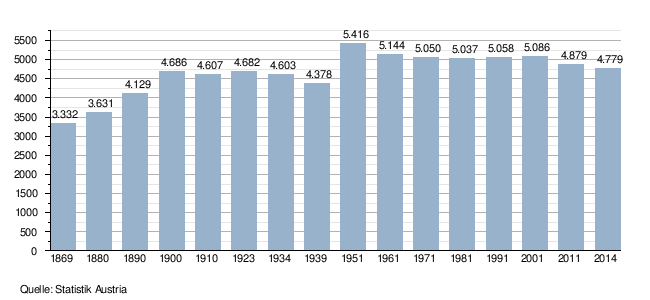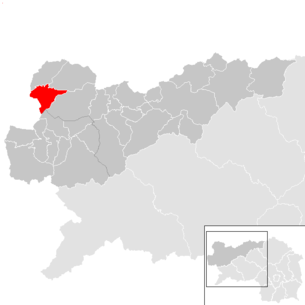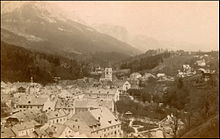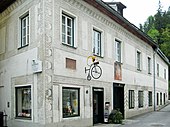Bad Aussee
|
Borough Bad Aussee
|
||
|---|---|---|
| coat of arms | Austria map | |
|
|
||
| Basic data | ||
| Country: | Austria | |
| State : | Styria | |
| Political District : | Liezen | |
| License plate : | LI | |
| Surface: | 81.86 km² | |
| Coordinates : | 47 ° 37 ' N , 13 ° 47' E | |
| Height : | 659 m above sea level A. | |
| Residents : | 4,830 (January 1, 2020) | |
| Postal code : | 8990 | |
| Area code : | 03622 | |
| Community code : | 6 12 07 | |
| NUTS region | AT222 | |
| UN / LOCODE | AT AUE | |
| Address of the municipal administration: |
Hauptstrasse 48 8990 Bad Aussee |
|
| Website: | ||
| politics | ||
| Mayor : | Franz Frosch ( ÖVP ) | |
|
Municipal Council : ( 2020 ) (21 members) |
||
| Location of Bad Aussee in the Liezen district | ||
 town hall |
||
| Source: Municipal data from Statistics Austria | ||
Bad Aussee is a spa town with 4830 inhabitants (as of January 1, 2020) in Styria , in the Styrian Salzkammergut , Liezen district and the judicial district of Liezen . Bad Aussee is considered the capital of the Ausseerland .
geography
Bad Aussee forms the geographical center of Austria ( center stone in the city spa park), lies at the confluence of the source rivers of the Traun and owes its origin to the salt mine near Altaussee and the associated salt pans (before 1300). Bad Aussee is connected to Upper Austria via two passes, the Pötschenpass and the Koppenpass . The Sommersbergsee is located in the municipality .
climate
|
Average monthly temperatures and precipitation for Bad Aussee
|
|||||||||||||||||||||||||||||||||||||||||||||||||||||||||||||||||||||||||||||||||||||||||||||||||||||||||||||||||||||||||||||||||||||||||||||||||||||||||||||||||||||||||
Community structure
The municipal area comprises eleven localities (population in brackets as of January 1, 2020):
- Anger (427)
- Bad Aussee (1011)
- Eselsbach (459)
- Gallhof (258) including Au, Gruben and Weißenbach
- Gschlößl (164) including Radling
- Lerchenreith (876) including Egg
- Obertressen (624) including Hanischbühel, Praunfalk and Vorwerk
- Reitern (351) including Voglbichl and forest
- Reith (281) including the Hintenkogl
- Sarstein (124) including Ischlberg and Sommersberg
- Unterkainisch (255) including Sießreith
The community consists of four cadastral communities (area: as of December 31, 2018):
- Bad Aussee (78.35 ha)
- Obertressen (295.76 ha)
- Reitern (1,659.98 ha)
- Strassen (6,168.97 ha)
Neighboring communities
| Altaussee | Grundlsee | |
| Bad Goisern Upper Austria |

|
Bad Mitterndorf |
| Obertraun Upper Austria | Grobming |
history
The first documented mention of the name was in 1246 as "Awse", in 1310 "Úzsê" is attested. The name probably goes back to the Slavic word for mouth ( Slovenian ustje ). The Altausseer and Grundlseer Traun flow into the Kainisch-Traun here . Until the 15th century, the Salzkammergut, including the Aussee and the Ausseerland, was the direct property of the emperor ( Kammergut ) . The Ausseerland came to Styria through a dispute over salt mining . A Religious Reformation Commission enforced the Counter Reformation in the now Protestant Ausseerland from 1599 .
In 1850 a kk district court , tax office and gendarmerie post was established . In 1868 Aussee was declared a health resort , and in 1877 the Salzkammergut Railway opened . In 1911 Aussee was given the title " Bad ".
During the time of the annexation of Austria , the Ausseerland was spun off into the administrative unit Reichsgau Oberdonau (Upper Austria). In 1942, the previously independent communities of Reitern and Strassen and the Obertressen district of the Grundlsee community were incorporated into Bad Aussee.
On July 1, 1948, the place came back to Styria. With the resolution of the Styrian state government on November 22, 1993, the city was named in 1994 . The numerous villas in the region, most of them built in the 19th century, testify to the wealth of the Styrian Salzkammergut.
The city was named Alpine City of the Year 2010.
Bad Aussee had a special place in the state administration due to its traditional status as a trading town, the topographical conditions and the peculiarities of its population. In the 19th and 20th centuries there was a tax office in Bad Aussee, there was a district court until 2005 and a district administrative authority until 2011 ( Politische Expositur Bad Aussee with the expiring license plate BA ). The latter has been run as a branch of the Liezen district administration since 2012.
Population development

Culture and sights
- Buildings
- Catholic parish church Bad Aussee Pauli Conversion: First mentioned around 1300, with a Gothic statue of the Virgin Mary of the type “Beautiful Madonna” and a tabernacle from the early 16th century.
- Holy Spirit Church: The church served as a chapel for the former saltworks hospital and was built by Emperor Friedrich III. (HRR) donated winged altar.
- Evangelical parish church Bad Aussee : consecrated in 1908 and elevated to parish church in 1921.
- The Kammerhof was first mentioned in a document in 1395 and was the official seat of the Salt Office until 1926 . A special feature of the Kammerhof is the Kaisersaal with its frescoes (1740–1756), in which Emperor Friedrich III. and Emperor Maximilian stayed.
- One of the listed buildings is the old stone mill , construction of which began before 1500. A special feature is the sgraffito decoration, which dates from around 1600. In the 18th century the building belonged to Josef Fröhlich, who came from Bad Aussee and who became an artisan at the court of Augustus the Strong , King of Saxony.
- Museums
- In Bad Aussee, the Kammerhof Museum is the central museum of the region. It has extensive collections on the history and folk culture of the Ausseerland. The collection focuses on archeology, salt and local history, traditional costumes, folk music, customs, fossils and caving. The Bad Aussee Alpine Garden presents classic Alpine flora and plants from other high alpine regions of the world.
- The private Lotus Museum in Bad Aussee offers an insight into the world of the car manufacturer Lotus .
- Show mine of the Altaussee salt mine : The exhibition series Kunst am Steinberg takes place in the rooms of the Altaussee show mine in the summer months . The imperial stable in Grundlsee is also used for exhibitions in the summer months.
- Other museums in the Ausseerland are
In 2005, the Styrian state exhibition was held in Bad Aussee under the motto "Fools and visionaries - with a pinch of salt" . The title alludes to the diverse customs, such as the drum women during the carnival season.
- Natural monuments
- The gorge and waterfalls on the Teichengrabenbach are protected natural monuments ( list entry ).
- Others
In the spring of 2005, the accessible bridge in the form of a Mercedes star, the Mercedes Bridge, was opened over the confluence of the Grundlseer and Altausseertraun .
The Chlumeckyplatz (also called Oberer Markt ) is also worth seeing . A small market takes place here once a week (late March to late November).
In the spa park there is a colorful fish fountain and the Archduke Johann monument. Bad Aussee is generally called the geographical center of Austria , the center stone is also in the city spa park.
Bad Aussee received the title Alpine Town of the Year 2010. Bad Aussee is recognized as a mediator between the town and the surrounding area in the Salzkammergut and for its active perception of the Alpine Convention .
From the Tressenstein waiting , which in 2013 at the peak of the centrally located between Lake Altaussee and Bad Aussee Tress stone was built, you can enjoy a magnificent view of Bad Aussee and a view over the whole Ausseerland.
Bad Aussee is also known as a stronghold of traditional costumes; traditional and modern costumes can be bought in several shops. In the Ausseerland, wearing the traditional costume is still widespread and also common in everyday life.
In Bad Aussee there are not just four seasons. Mardi Gras is the "fifth season". Drum women, Flinserln and Maschkera create a colorful picture in the town center. A wide variety of carnival events take place in all parts of the village from Thursday to Shrove Tuesday.
In the state flower decoration competition "Die Flora" | 19 Bad Aussee was one of the seven Styrian cities and received a total of five floras, making it one of the state's winners.
Economy and Infrastructure
Tourism is an essential economic factor : classic summer retreats ( health resort since 1868, title " Bad " since 1911, sole spa , Grundlsee and Altausseer See ) and winter sports ( Loser ski area ). The Daffodil Festival takes place at the end of May, attracting around 25,000 visitors every year.
Bad Aussee has always been characterized by gentle tourism. The increasing number of second homes is characteristic of the entire region (so it happens that Bad Aussee has around 2700 second homes - for one main home there are already 0.5 second homes).
One of the largest employers in the municipality is Rigips Austria, which has its Austrian headquarters in Bad Aussee.
The trade is primarily characterized by independent retail stores, almost all of which are located in the center of the town with mostly very small shops.
Together with Altaussee, Bad Mitterndorf and Grundlsee, the municipality forms the “Ausseerland-Salzkammergut” tourist association. Its seat is in Bad Aussee.
The Archduke Johann BORG Bad Aussee , an upper secondary school , goes back to a private middle school founded in 1950, came to the municipality of Bad Aussee in 1964 and has been a federal school since 1978 .
Sports
For a long time the most important representative of Aussee sport was the SV Bad Aussee football club. This club, which was founded in 1932, rose from the Central Regional League to the First League in 2007 and thus celebrated the greatest success in the club's history. The home stadium is the panorama stadium near the train station. The last president of SV Bad Aussee was the German employer president Dieter Hundt . At the time it was part of the First League, SV Bad Aussee was the largest advertising medium in the town of Bad Aussee with an advertising value of around 1.9 million euros. After the equalization and dissolution of the club, FC Ausseerland was created as a new club in Bad Aussee in cooperation with FC Altaussee. The Presidium consists of the industrialist Hans Christof and the former Styrian Provincial Councilor Günter Dörflinger.
politics
The municipal council has 21 members.
- With the municipal elections in Styria in 2000, the municipal council had the following distribution: 14 SPÖ, 9 ÖVP, 1 FPÖ and 1 Greens. (25 members)
- With the municipal council elections in Styria in 2005 , the municipal council had the following distribution: 16 SPÖ, 8 ÖVP, and 1 fools & visionaries. (25 members)
- With the municipal elections in Styria in 2010 , the municipal council had the following distribution: 12 SPÖ, 10 ÖVP, 2 FPÖ and 1 Greens. (25 members)
- With the municipal elections in Styria in 2015 , the municipal council had the following distribution: 12 ÖVP, 6 SPÖ and 3 Greens.
- With the municipal council elections in Styria 2020 , the municipal council has the following distribution: 12 ÖVP, 6 SPÖ and 3 Greens.
mayor
- 1975–1990 Erhard Meier (SPÖ)
- 1990–1995 Michael Roithner (SPÖ)
- 1995–2000 Günther Köberl (ÖVP)
- 2000-2013 Otto Marl (SPÖ)
- since 2013 Franz Frosch (ÖVP)
coat of arms
The municipal coat of arms was awarded with effect from June 1, 1994.
Blazon (coat of arms description):
- "Two golden salt vats next to one another notched at the edges in a divided shield above in red, below a golden char swimming to the left in gold-flooded blue."
Partnerships
- since 1981: Plaisir in the French Yvelines department
Personalities
Honorary citizen of the community
- Berthold Großauer († 1955)
- 1976: Friedrich Niederl (1920–2012), Governor of Styria 1971–1980
- 1976: Franz Wegart (1918–2009), Deputy Governor
Sons and daughters of the church
- Anna Plochl (1804–1885), wife of Archduke Johann
- Michael Moser (1853–1912), photographer
- Josef Poestion (1853–1922), Scandinavian
- Gunther Burstyn (1879–1945), technician and officer in the Austro-Hungarian Army
- Albrecht Gaiswinkler (1905–1979), resistance fighter against National Socialism
- Albert Hofbauer (1910–1991), politician (SPÖ)
- Karl Amon (1924–2017), church historian
- Elly Lieber (* 1932), luge rider
- Gerlinde Haid born Hofer, (1943–2012) folklorist, researcher on alpine songs
- Klaus Maria Brandauer (* 1943), actor and director, professor at the Max Reinhardt Seminar
- Peter Rastl (* 1945), computer scientist, is known as the "father of the Internet" in Austria
- Alfred Komarek (* 1945), writer
- Evelyn Kuwertz (* 1945), German painter
- Manfred Nowak (* 1950), lawyer and UN special rapporteur on torture
- Csaba Székely (* 1951), railway manager and transport scientist
- Irmtraud Fischer (* 1957), theologian
- Ernst Grieshofer (* 1960), jazz and fusion musician
- Alfred Jaklitsch (* 1960), musician, composer, founder of the band Die Seer
- Andreas Bruchhäuser (* 1962), German painter
- Peter Hinterdorfer (* 1963), physicist
- Martina Kaller-Dietrich (* 1963), historian and Latin Americanist
- Thomas Loidl (* 1964), diplomat, ambassador to Vietnam
- Johanna Köberl (* 1965), politician (SPÖ)
- Gerhard Friedl (1967–2009), filmmaker
- Ulla Weigerstorfer (* 1967), Miss Austria and Miss World 1987
- Christian Ortner (* 1969), historian and museum director
- Barbara Wolfgang-Krenn , b. Krenn (1969-2019), entrepreneur and politician (ÖVP)
- Ernst Gottschmann (* 1971), musician
- Flow Bradley (born 1974), singer and composer
- Klaus Schrottshammer (* 1979), speed skier
People related to the community
- Eduard von Feuchtersleben (1798–1857), mining engineer and man of letters, died in Bad Aussee
- Joseph von Schmerling (1806–1884), officer, died in Bad Aussee
- Marie von Najmájer (1844–1904), writer, died in Bad Aussee
- Clara Schreiber (1848-1905), played a decisive role in the establishment and management of the sanatorium alpine lake
- Max Cordignano (1851–1898), architect and builder; lived, worked and died in Bad Aussee
- Karl Benyovszky (1886–1962), writer and journalist; lived and died in Bad Aussee
- Adolf A. Friedländer (1870–1949), neurologist, died in Bad Aussee
- Oskar Strnad (1879–1935), architect, designer and set designer, died in Bad Aussee
- Hugo Cordignano (1882–1959), musician and artist; lived and worked in Bad Aussee
- Heinz Hanus (1882–1972), film director and screenwriter, died in Bad Aussee
- Rudolf Forster (1884–1968), actor, died and buried in Bad Aussee
- Friedrich Czermak (1890–1960), geologist, died in Bad Aussee
- Emmy Haesele (1894–1987), graphic artist and painter, lived in Bad Aussee from 1948 to 1956
- Hans Gielge (1901–1970), teacher, cultural activist, folk song collector and dialect poet in Bad Aussee
- Werner Ostendorff (1903–1945), German SS officer, died in Bad Aussee
- Erich Bielka (1908–1992), diplomat and politician, died in Bad Aussee
- Herbert von Karajan (1908–1989), conductor, lived a. a. in Bad Aussee
- Wilhelm Höttl (1915–1999), SS officer, head of the Bad Aussee private middle school
- Hans Bürkle (1919–1993), politician (ÖVP), died in Bad Aussee
- Jutta Bornemann (1920–1999), actress and screenwriter, died in Bad Aussee
- Josef Hans Grafl (1921–2008), resistance fighter against National Socialism, lived and died in Bad Aussee
- Dieter Hundt (* 1938), German entrepreneur, employer and football official, lives a. a. in Bad Aussee and was president of SV Bad Aussee
- Heidemarie Lex-Nalis (1950–2018), pioneer of elementary education in Austria, lived in Bad Aussee for many years
- Simone Kopmajer (* 1981), jazz singer, grew up in Bad Aussee
literature
- Bad AUSSEE . Chapter in: Andreas Lippert (Ed.): Reclams Archaeological Guide Austria and South Tyrol . Philipp Reclam jun., Stuttgart 1985, ISBN 3-15-010333-9 .
- Stephen Sokoloff: "Golden Paths", cultural and natural treasures in the Inner and Styrian Salzkammergut, Verlag Neumedia, 2008.
- Migros-Genossenschafts-Bund (Ed.): Festivals in the Alpine region. Migros-Presse, Zurich, 1997. ISBN 3-9521210-0-2 , p. 103.
Web links
- 61207 - Bad Aussee. Community data, Statistics Austria .
- Web presence of the municipality of Bad Aussee
- Videos and audio files from or about Bad Aussee in the online archive of the Austrian Media Library (carnival customs, folk dances, memories, ...)
Individual evidence
- ↑ Statistics Austria: Population on January 1st, 2020 by locality (area status on January 1st, 2020) , ( CSV )
- ↑ CSV file from REGIONALINFORMATION.zip (1,221 kB) ; accessed on January 12, 2019
- ^ Manfred Niemeyer (ed.): German book of place names . De Gruyter, Berlin 2012, ISBN 978-3-11-018908-7 , pp. 44 .
- ↑ Current version: Ordinance of the Styrian Provincial Government of May 30, 1980 on the establishment of the Bad Aussee spa district Main version: LGBl. No. 52/1980
- ↑ Nature adventure center Alpengarten Bad Aussee. Retrieved May 20, 2014 .
- ^ Club Lotus Austria: The Museum. Retrieved May 20, 2014 .
- ↑ Media release on the announcement of Bad Aussee as Alpine City of the Year 2010 (PDF; 41 kB)
- ↑ Flower decoration competition "Die Flora"
- ^ Grazer Zeitung , Official Gazette for Styria. December 30, 2014, 210th year, 52nd piece. No. 299. ZDB -ID 1291268-2 p. 624.
- ^ Result of the 2005 municipal council election in Bad Aussee. State of Styria, March 13, 2005, accessed on July 26, 2020 .
- ^ Election result of the municipal council election 2010 in Bad Aussee. State of Styria, March 21, 2010, accessed on July 26, 2020 .
- ^ Election results for the 2015 municipal council elections in Bad Aussee. State of Styria, March 22, 2015, accessed on July 26, 2020 .
- ↑ Results of the 2020 municipal council elections in Bad Aussee. State of Styria, June 28, 2020, accessed on July 26, 2020 .
- ↑ Otto Marl Ennstalwiki
- ↑ Franz Frog Ennstalwiki
- ^ Notices from the Styrian State Archives 47, 1997, p. 35
- ↑ Steirischer Bauernbündler (May 15, 1955), p. 3.
- ↑ Südost-Tagespost (May 30, 1976), p. 5.
- ↑ Südost-Tagespost (May 30, 1976), p. 5.












